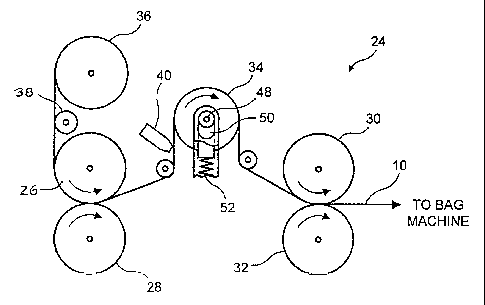Une partie des informations de ce site Web a été fournie par des sources externes. Le gouvernement du Canada n'assume aucune responsabilité concernant la précision, l'actualité ou la fiabilité des informations fournies par les sources externes. Les utilisateurs qui désirent employer cette information devraient consulter directement la source des informations. Le contenu fourni par les sources externes n'est pas assujetti aux exigences sur les langues officielles, la protection des renseignements personnels et l'accessibilité.
L'apparition de différences dans le texte et l'image des Revendications et de l'Abrégé dépend du moment auquel le document est publié. Les textes des Revendications et de l'Abrégé sont affichés :
| (12) Brevet: | (11) CA 2366835 |
|---|---|
| (54) Titre français: | METHODE DE TRAITEMENT DES FERMETURES A GLISSIERE POUR ENLEVER LA CAMBRURE |
| (54) Titre anglais: | METHOD OF TREATING ZIPPER TO REMOVE CAMBER |
| Statut: | Périmé et au-delà du délai pour l’annulation |
| (51) Classification internationale des brevets (CIB): |
|
|---|---|
| (72) Inventeurs : |
|
| (73) Titulaires : |
|
| (71) Demandeurs : |
|
| (74) Agent: | FINLAYSON & SINGLEHURST |
| (74) Co-agent: | |
| (45) Délivré: | 2005-07-05 |
| (22) Date de dépôt: | 2002-01-03 |
| (41) Mise à la disponibilité du public: | 2002-08-06 |
| Requête d'examen: | 2002-01-03 |
| Licence disponible: | S.O. |
| Cédé au domaine public: | S.O. |
| (25) Langue des documents déposés: | Anglais |
| Traité de coopération en matière de brevets (PCT): | Non |
|---|
| (30) Données de priorité de la demande: | ||||||
|---|---|---|---|---|---|---|
|
A method and apparatus for removing camber from zipper with profiles having
interlocking elements and or webs. The zipper is stretched longitudinally in a
manner so that the
interlocking elements stretch relative to each other. To this end, the zipper
is fed to an idler
wheel that may be spring loaded. From a set of first drive wheels and fed from
the idler wheel
by a set of second drive wheels. The second drive wheels are driven faster
than the first drive
wheels to effect the stretching. Alternately only the second set of drive
wheels are driven and
the stretch is provided by the spring loaded idler wheel or the zipper is
driven around a static
curved surface.
Note : Les revendications sont présentées dans la langue officielle dans laquelle elles ont été soumises.
Note : Les descriptions sont présentées dans la langue officielle dans laquelle elles ont été soumises.

2024-08-01 : Dans le cadre de la transition vers les Brevets de nouvelle génération (BNG), la base de données sur les brevets canadiens (BDBC) contient désormais un Historique d'événement plus détaillé, qui reproduit le Journal des événements de notre nouvelle solution interne.
Veuillez noter que les événements débutant par « Inactive : » se réfèrent à des événements qui ne sont plus utilisés dans notre nouvelle solution interne.
Pour une meilleure compréhension de l'état de la demande ou brevet qui figure sur cette page, la rubrique Mise en garde , et les descriptions de Brevet , Historique d'événement , Taxes périodiques et Historique des paiements devraient être consultées.
| Description | Date |
|---|---|
| Le délai pour l'annulation est expiré | 2008-01-03 |
| Lettre envoyée | 2007-01-03 |
| Inactive : CIB de MCD | 2006-03-12 |
| Accordé par délivrance | 2005-07-05 |
| Inactive : Page couverture publiée | 2005-07-04 |
| Préoctroi | 2005-04-15 |
| Inactive : Taxe finale reçue | 2005-04-15 |
| Lettre envoyée | 2004-10-18 |
| month | 2004-10-18 |
| Un avis d'acceptation est envoyé | 2004-10-18 |
| Un avis d'acceptation est envoyé | 2004-10-18 |
| Inactive : Approuvée aux fins d'acceptation (AFA) | 2004-10-05 |
| Modification reçue - modification volontaire | 2004-09-08 |
| Inactive : Dem. de l'examinateur par.30(2) Règles | 2004-04-16 |
| Inactive : Dem. de l'examinateur art.29 Règles | 2004-04-16 |
| Demande publiée (accessible au public) | 2002-08-06 |
| Inactive : Page couverture publiée | 2002-08-05 |
| Inactive : CIB attribuée | 2002-03-07 |
| Inactive : CIB en 1re position | 2002-03-07 |
| Inactive : CIB attribuée | 2002-03-07 |
| Inactive : CIB attribuée | 2002-03-07 |
| Inactive : Certificat de dépôt - RE (Anglais) | 2002-02-05 |
| Lettre envoyée | 2002-02-05 |
| Lettre envoyée | 2002-02-05 |
| Demande reçue - nationale ordinaire | 2002-02-05 |
| Exigences pour une requête d'examen - jugée conforme | 2002-01-03 |
| Toutes les exigences pour l'examen - jugée conforme | 2002-01-03 |
Il n'y a pas d'historique d'abandonnement
Le dernier paiement a été reçu le 2004-12-22
Avis : Si le paiement en totalité n'a pas été reçu au plus tard à la date indiquée, une taxe supplémentaire peut être imposée, soit une des taxes suivantes :
Les taxes sur les brevets sont ajustées au 1er janvier de chaque année. Les montants ci-dessus sont les montants actuels s'ils sont reçus au plus tard le 31 décembre de l'année en cours.
Veuillez vous référer à la page web des
taxes sur les brevets
de l'OPIC pour voir tous les montants actuels des taxes.
| Type de taxes | Anniversaire | Échéance | Date payée |
|---|---|---|---|
| Taxe pour le dépôt - générale | 2002-01-03 | ||
| Enregistrement d'un document | 2002-01-03 | ||
| Requête d'examen - générale | 2002-01-03 | ||
| TM (demande, 2e anniv.) - générale | 02 | 2004-01-05 | 2003-12-23 |
| TM (demande, 3e anniv.) - générale | 03 | 2005-01-04 | 2004-12-22 |
| Taxe finale - générale | 2005-04-15 | ||
| TM (brevet, 4e anniv.) - générale | 2006-01-03 | 2005-12-30 |
Les titulaires actuels et antérieures au dossier sont affichés en ordre alphabétique.
| Titulaires actuels au dossier |
|---|
| ILLINOIS TOOL WORKS INC. |
| Titulaires antérieures au dossier |
|---|
| ZDENEK MACHACEK |